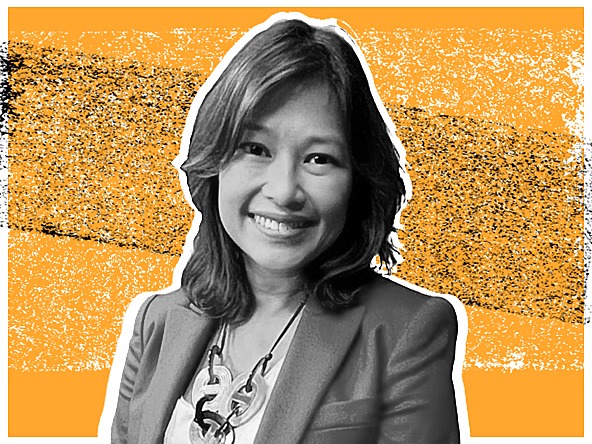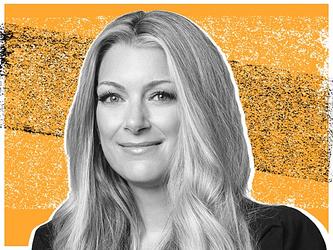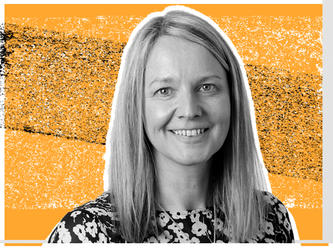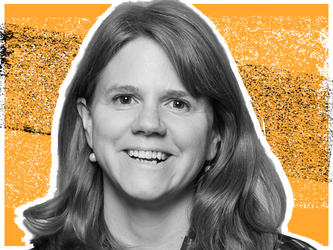How I work: Elaine Rodrigo, chief insights and analytics officer, Reckitt

Katie McQuater (KM): What does an average day look like for you?
Elaine Rodrigo (ER): I work from home two or three days a week, so it varies. I have two or three days in person – it could be at the office or it could be at our advertising agency.
On the average morning, I’m up by about 6.45-7am, sometimes earlier. I have a 15-year-old still at home, my older daughter is 18 and is off at university. My 15-year-old is very independent, but the mornings are about seeing her, seeing her off to school, having breakfast, so that’s how the day starts. If I’m working from home, I usually try to do a bit of food prep for the evening meal. If I go into the office, I usually leave by about 7.30am.
It’s really about getting all the personal things in order so that the end of the day doesn’t become a nightmare.
KM: Do you have any preference on working from home versus working in an office?
ER: Now, we call it hybrid, but I’ve actually been working like in this way since 2010. I was at Kraft Foods in Singapore when we implemented a two-days-a-week work from home policy. I was travelling 50% of the time and working from home two days a week, so I was at the office maybe six or eight working days a month.
Skype was just starting, so I remember that when you had video calls with the US, for example, you had to go into the office. Sometimes I was in the office from 7pm until 2am when I had some of those calls. So, I was already used to working in that hybrid fashion.
I like hybrid, but I like being in control of my own calendar and agenda and I manage my work week in the way that’s most productive for what I need to get done. However, I think face-to-face time is important. I don’t think anybody needs to be in the office five days a week just to be there, what’s the point?
When I’m at home I’m extremely productive in terms of quiet time, thinking time, but when I go into the office, I make sure I’m meeting people. Sometimes things happen and a day that was meant to be full of face-to-face meetings in the office suddenly shifts overnight to Teams and Zoom, for whatever reason – then I just don’t go in.
I’ve been going back to the office about two or three days a week since post-summer last year. It took a bit of getting used to, as in the beginning I was getting frustrated because I felt less productive. I have a 45-minute commute each way and let’s face it, getting ready to go to the office requires a little bit more time and effort around thinking about what shoes to wear, for example! So, to some extent, I ‘lose’ two hours a day when I go into the office.
But I realised that the definition of productivity had changed during Covid. Productivity was just getting the work done and getting it out there. Obviously, that’s important, but how do you put a number on engagement and meeting with people, feeling like you’re part of an organisation?
It’s not just about yourself, but as leaders it’s about the people who work below us – corridor conversations and seeing people you haven’t seen for a long time. You can’t really put a number on that.
I go into the office and by the end of the day I’ve had eight meetings and I haven’t answered one email. But that sort of stuff can be done at home, so usually I try to manage it in such a way that I’ll go into the office on Tuesdays and Thursdays, and I block out the first couple of hours on Wednesday and Friday mornings to action everything that I discussed the day before. I learned that from the first year of Covid because we were in all these meetings with no time to action anything, so we ended up working on things from 8pm until 11pm. And that’s just not right. So, I manage my calendar quite closely.
KM: It sounds like you’re not letting the emails rule you. How do you manage your time when working as a global team?
ER: We’re all travelling and working different hours. Just because you send an email at a particular time doesn’t mean that you expect a response at that time. But it’s about signalling and making it clear to everyone else as well.
There are times when I’ve worked at strange hours. Managing my calendar is one thing, but from a personal perspective, I manage my energy and not my time. If I’m tired, I just stop. It sounds simple, but some days I’ve just run out of energy at 4pm, maybe because I’ve been travelling, so if I don’t have a meeting I’ll just stop. Sometimes I’ll go to bed early and end up waking up at 4am and I’ll be well rested and energised and I’ll work then.
So, I don’t fixate on having to work between certain hours, I keep it fluid. But you do need to be careful in terms of knowing where to draw the line. You’ve got to manage it. It’s not like 24/7 is always about work, because that’s the problem.
KM: How do you maintain work-life balance?
ER: Family is obviously a big part of it – making time for my children. But with one at uni and the other one now older, I have more time for myself as well. I get a lot of energy from people, generally. I get a lot of energy from being around the people I work with, my team, but also friends and family. I schedule in social things quite far in advance and I always make sure I book things in, because otherwise you’ll never do it.
At the same time, I try not to overdo it. Last weekend, I decided to book in time just to be at home by myself – have a nap and read a book, because it felt like it had been non-stop the whole of January, and Chinese new year the weekend before was really busy, so I thought maybe I should just take it easy.
KM: How do you encourage your teams to have good boundaries?
ER: I manage my team for priorities and outcomes, and I’m not really fussed about how they do it day-to-day. I really don’t care what time they wake up. And because I’ve always been a working parent and raising them in a dual career parenting situation, I really get it. I really get how hard it is, especially when they are little.
I won’t speak for the men, but for myself, as a woman, the most important thing for me was flexibility. All I needed was flexibility, I honestly didn’t need any cutting back of my priorities. I just needed flexibility, for example, time between three and four to go and pick my children up after school. But I was quite happy working a second shift at night. It’s about the moments that count, so after school is nice when they’re little because they tell you all about their day. So that’s usually an important moment, bedtime is an important moment, and then you have your own dinner with your partner, but I could go on and then work again after that – and it was my own decision to do that.
You’ve got to be careful about how you manage your body when you’re working these hours, making sure you get enough exercise and watching your diet, making sure you have enough sleep, exercise, diet and manage your mental energy and emotional energy.
KM: How do you spend your commute on office days?
ER: When I first started going back to the office I was just frustrated by the downtime – it was just making me cranky, so I wanted to turn the time into something productive. Some friends told me they quite enjoyed the commute because during Covid they were always switched on and it was quite nice to just sit there and listen to the radio. In my case I always have to be thinking, but I don’t always have to be thinking about work.
I had signed up for Masterclass but I had never had the chance to listen to it because honestly, when I’m finished for the day, I just want to watch Netflix! As much as I want to listen to Indra Nooyi and Hillary Clinton and Bob Iger, I didn’t want to listen to it at 9pm.
So, I now listen on the drive or the Tube and it’s been really good. It has helped me feel less frustrated about that downtime in traffic. Now, I think of it as that I have picked up a few hours a week where I’m actually spending time on myself and my own learning. I started with all the strategic business ones and now I’m starting to branch into what they do at Vogue, and I’m also starting to listen to things that I normally wouldn’t have any interest in, because you don’t know what you don’t know. I’m investing that extra few hours a week of what would otherwise be dead time into myself. Sometimes, I also do short work calls, but I don’t do anything where I need to make a decision.
Commuting again is a bit of readjustment, and at the beginning I was really tired. I’d been travelling for 50% of my time for 20 years, I don’t get jet lag and I’m a really good traveller, but I did a business trip and wondered why I was so tired. It’s just because that muscle had not been used for two years. But other, new muscles have been built.
KM: Are there any other tips and tricks you’ve learned over the years? What helps you most with productivity?
ER: For all of us in our industry, market research is a partnering function so it’s about being impactful in the organisation. I’ve been on the client side for over 20 years and I’ve been leading the function for a number of years now and I make sure that I always link everything that we do to a business question and I always put a number on it.
You also need to be agile. What we do in CMI, in insights and analytics, is we build over time, because we build knowledge and capabilities. We can’t be moving around like a pendulum all over the place, but we obviously keep evolving and we need to be agile. What I always make sure we do is link work to a business question, to the narrative of the organisation at that time. I don’t keep changing what my team is doing all the time, but I do a shift a little bit in terms of how we talk about it.
As we enter 2023, many clients are preparing for a tough year. Inflation, cost of goods, cost of living, potential looming economic recession – you’ve got to be prepared for these things. Now, what I’m doing is being really brutal around what we’re working on and really making some tough choices, and if it doesn’t link to a business question, ask yourself why you are doing it. It’s about taking a pause.
Another of my tips is that I very clearly know what my two or three priorities are. These are things I will never stop doing or talking about – even if every resource was somehow taken from me. One of them is in the area of growth and demand spaces, what I call demand-centric growth, because this is the foundation of consumer-centric thinking in the organisation. If you don’t have that, you basically rip up the foundation.
The second is about marketing media spend optimisation and all the modelling that we do, because you always need to find fuel for the organisation. If you’re helping the company find money, you will always have a reason for being. The idea is how can I help the company find growth and how do I help the company find fuel – and then there’s everything else.
It’s different from how it used to be, where this was your job title, this is what you do and this is how it’s going to be forever. It’s small degrees of separation, but things shift, so for example, today you’re working on marketing optimisation but maybe tomorrow you’re working on a full-funnel digital optimisation. You’ve got to be able to pivot. You need to understand what the questions are at a given moment and then adjust the skillsets. It’s about evolving the way we think about competencies versus “I am a shopper specialist” or “I know how to do forecasting” but to think about skillsets instead.
KM: How do you stay focused?
ER: Anything that’s multitasking isn’t a good thing. There’s a lot going on, but I usually try to focus on doing one or two things and then finishing them.
KM: What are you prioritising at the moment?
ER: I’m spending a lot of time on two things. One is continuously evolving our tools to make sure we’re always thinking 12 months ahead.
Separately, I’m working on looking at the big capabilities of the future, three-to-five years from now – things like everything becoming much more end-to-end. If that’s the future, what kind of capabilities, resources and skillsets do we need? Because then I can start to adjust my group accordingly to start skilling up in some of these things so that when the time comes, we’re ready to meet that.
I’m working a little bit more in the mid-term to long-term and leaving my team to manage more of what’s closer in, because we’ve already had two years of building the foundations.
This interview has been lightly edited for clarity.

We hope you enjoyed this article.
Research Live is published by MRS.
The Market Research Society (MRS) exists to promote and protect the research sector, showcasing how research delivers impact for businesses and government.
Members of MRS enjoy many benefits including tailoured policy guidance, discounts on training and conferences, and access to member-only content.
For example, there's an archive of winning case studies from over a decade of MRS Awards.
Find out more about the benefits of joining MRS here.














0 Comments